Lease Termination Letter Templates (30-day Notice)
Ending a contract should always be as legal as starting it. That’s why a written termination notice or agreement should be acknowledged by either the landlord or tenant. To assist you, FormsPal has created a free termination letter template (30-day notice to vacate) for ending a month-to-month lease below. This article also contains a quick guide on how to end your lease so you’re not terminating the contract blindly.
Terminating a lease agreement highly depends on what type of termination agreement you’ve entered and why you’re ending the contract. Here are the different types of notices that you can send:
1. Lease Termination Letter – This is the type of letter intended for ending a month-to-month lease, which is short-term. In this letter, a tenant or a landlord expresses the intent to no longer renew the monthly lease.
2. Early Lease Termination Letter – If you need to end the contract earlier than the agreed end date (e.g. a fixed-term lease or long-term lease), this type of letter will be applicable. Using an early termination letter can be disadvantageous to the party that initiated it as certain penalties may apply. Of course, this highly depends on the original lease agreement’s default provisions. More often than not, the security deposit is forfeited based on the long-term lease’s termination clause.
3. Notice to Quit – This type of notice can be used if the tenant breaks the agreement. The landlord may send a stern Notice to Quit if the breach of contract has not been remedied by the tenant within the given time frame. Depending on the eviction procedure in the contract, the landlord can draft a notice to quit as long as it abides by state laws.
If you’re dealing with a month-to-month or periodic lease, you may download and edit the free template below.
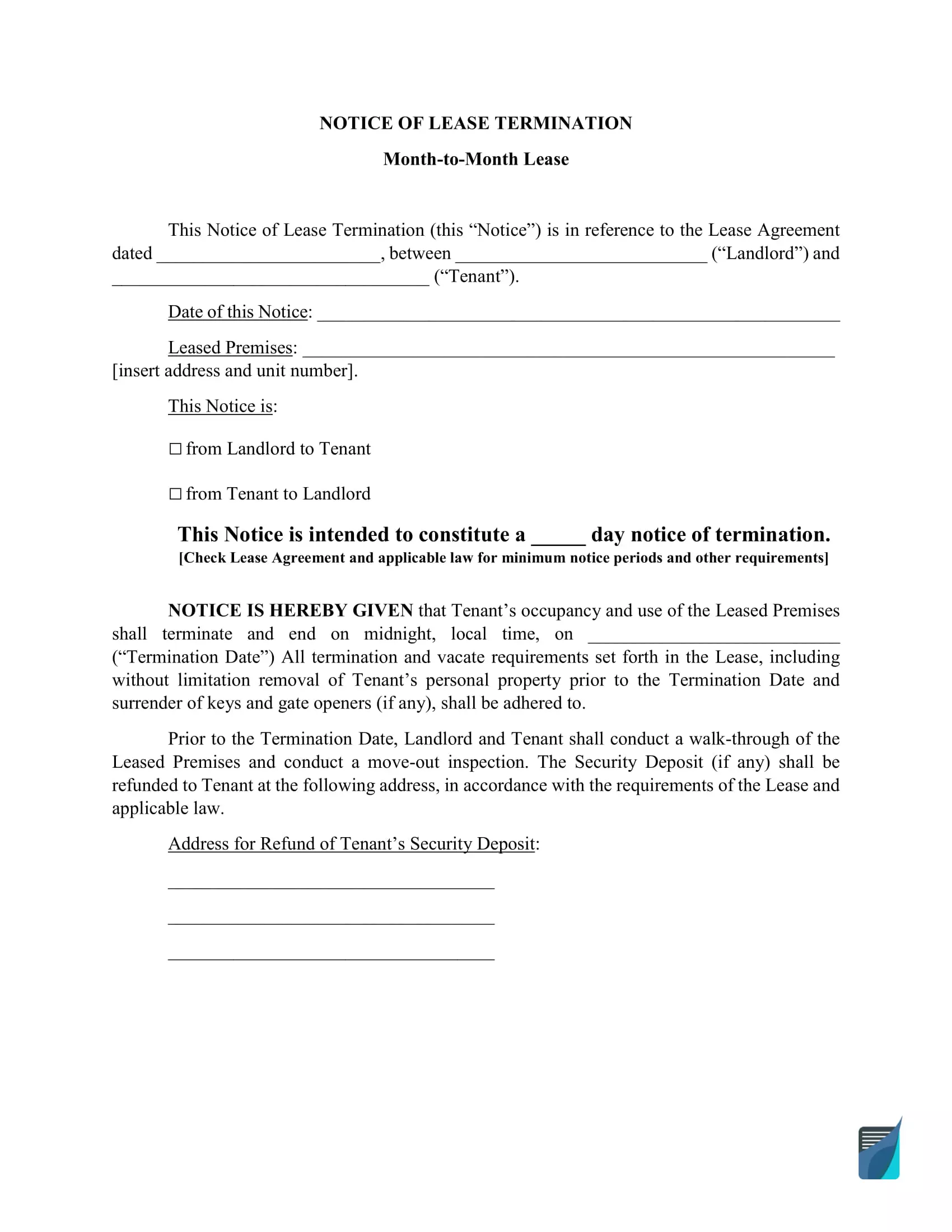
Build Your Document
Answer a few simple questions to make your document in minutes
Save and Print
Save progress and finish on any device, download and print anytime
Sign and Use
Your valid, lawyer-approved document is ready
Terminating a Lease Agreement
Even though the landlord and the tenant may be living amicably, there may still be reasons why a rental agreement will turn into a lease termination agreement. They might be the following:
Landlord’s Reasons for Lease Termination
- The apartment or house is now for sale
- It is now uninhabitable (was destroyed or has a health hazard).
- It is now being taken by the bank or the government
- The property will be remodeled
- Landlord suspects tenants of illegal or drug-related dealings
- The landlord did not receive rent from the tenant.
- The tenant did not follow the agreements in the contract
Tenant’s Reasons for Lease Termination
- The tenant’s job has required him to move to another location.
- Change in lifestyle (getting married, getting pets, etc.)
- Has experienced health issues while living on the premises (which could be traced to the landlord’s negligence)
- The landlord has not kept his or her part in the contract
- The tenant has been called to serve in the military
- He or she has an emergency situation (e.g. must return home to take care of sick parents)
What if I don’t use a Termination Letter?
Not using a lease termination letter is similar to using verbal contracts—they’re “real” and binding, but only if the other party acknowledges it. What if the other person denies your termination agreement? It’ll be your word against his or her word.
A letter for lease termination is important because it can be a form of evidence should the problem be taken to court during the eviction proceedings. If either party fails to formally terminate a contract, the terms are still in force and the following could be possible complications:
- Tenants can still be charged rent even when they have already vacated
- Tenants can be charged for damages to the premises, which they might have not done.
- Tenants will automatically forfeit the entire security deposit
- Landlords are at risk of being charged with illegal eviction
- The Landlord’s property will be tagged as the “last known address” in case anything happens to the tenant
Lastly, formalizing the end of your lease will be helpful if the contract does not have a termination clause. The letter will then detail what will happen and what process must be observed by both the landlord and the tenant.
Lease Termination Letter Form Details
| Document Name | Lease Termination Letter Form |
| Other Names | 30-Day Notice to Vacate, Termination of Lease Letter |
| Avg. Time to Fill Out | 9 minutes |
| # of Fillable Fields | 27 |
| Available Formats | Adobe PDF |
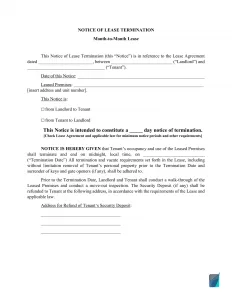
Steps to Filling Out a Lease Termination Letter
Step 1— Download the lease termination letter template.
The free lease termination template below is editable and printable. You can download either of the three different formats (PDF, DOC, and ODT) below:
- Lease Termination Letter Template (DOC)
- Lease Termination Letter Template (ODT)
- Lease Termination Letter Template (PDF)
If you don’t have a Microsoft Word program installed on your computer, you may download and install the Open Office program for free.
Step 2— Refer back to the original lease agreement.
It is highly important to go back and review the original agreement for any guidelines and consequences to terminating it. Have your original contract in hand when you edit the template so that you can copy the information as accurately as possible.

In the first paragraph of the lease termination letter, you will need to copy some details from the original contract of lease. Those are the following:
- Blank 1: Date of when the original contract was signed. This is usually indicated in the first paragraph of rental agreements. Take note that this is different from the date the tenant moved into the premises.
- Blank 2: Write the full name of the owner or landlord.
- Blank 3: Write the full name of the renter or tenant.
- Blank 4: Indicate the date when the notice was signed.
- Blank 5: Type the complete address of the premises indicated in the rental agreement. Remember to put the following details (if applicable): unit number, floor, building number, street, area, city, county, state, zip code.
Step 3— Indicate the sender and receiver of the notice.
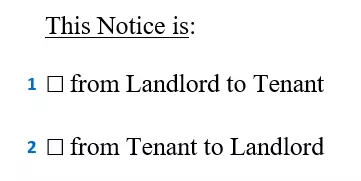
Choose either of the two boxes. The first box is applicable if you are the landlord and the second box is if you are the tenant. Regardless of which party you are in a lease, signatories to the original contract must still thoroughly check their state’s laws regarding the termination of tenancy.
Step 4— Complete the paragraph that states the reason for the notice.
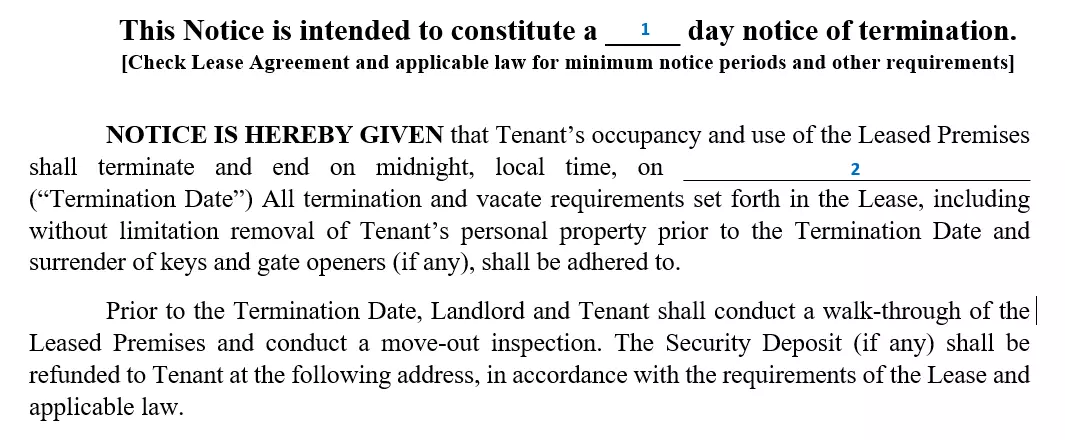
This section answers the following questions:
- How long does the tenant have to leave the apartment, room, or house? (blank 1)
- By when must the tenant leave? (blank 2)
- What should be his or her final obligations to the lease contract? (Paragraph 2)
- In what manner will the turnover be done? (Paragraph 3)
Therefore, the following should be written on each blank:
- Blank 1: The number of days given to the tenant to follow the guidelines of the notice. This is proceeded by a dash (e.g. “30- day notice of termination”). In most states, a 30-day notice to vacate is the minimum reasonable timeframe given by landlords. However, if it is the tenant who wants to end the lease, he or she may go below this duration as long as the situation calls for urgency. The law permits an early out if, for example, the tenant will be deployed in the army, if there is an emergency, or if the apartment or unit is no longer habitable.
- Blank 2: Write the exact end date of the timeframe above.
At this point, you may refer back to the contract and list down the “termination and vacate requirements” stated there. Alternatively, you may also make a copy of the contract, highlight that section, and attach it to this notice.
Step 5— Add the tenant’s permanent or new address.
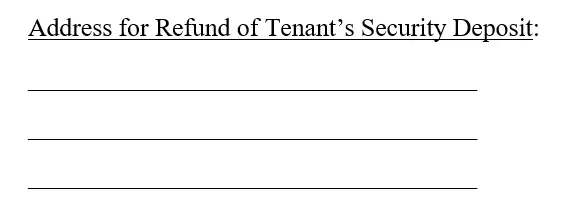
Since the landlord may not be able to give back the security deposit right away, the tenant must indicate his or her new forwarding address. This is where the refund will be sent (provided that no obligations were left unpaid). Aside from this, you may also indicate the contact information (phone number and e-mail address), a designated receiver (write the full name), or the tenant’s account details.
Step 6— Explain the reason for the end of lease.
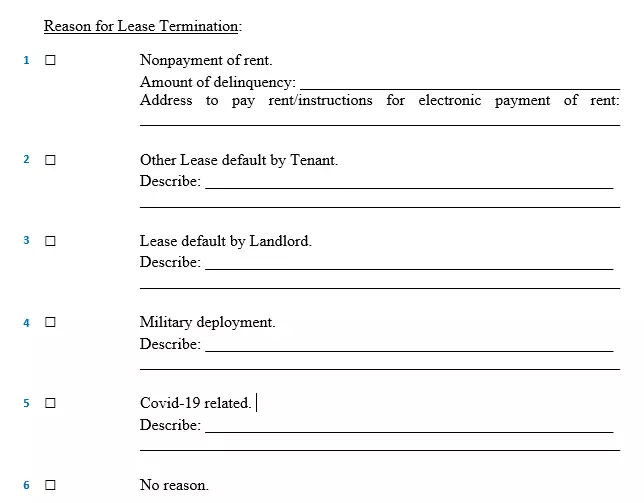
Next, tick the box that applies to your situation:
- Box 1: Select this box if the landlord is terminating the rent due to the tenant’s nonpayment. On the first box, write the total amount of his or her outstanding rental bill. Then, on the second blank, write the landlord’s bank account details for settling the balance.
- Box 2: Choose this if the tenant also breached the contract and disregarded its terms. You may copy the exact wording from the original contract terms and write it on the corresponding blank.
- Box 3: If the landlord breached the contract, tick this box. Likewise, copy the terms that the landlord did not honor and write it on the blank provided.
- Box 4: If a military deployment is the reason, simply tick the box. You may also write additional details like the date of deployment.
- Box 5: Though it is not lawful to evict people who have contracted Covid-19, termination of contracts can happen if tenants do not follow safety protocols, therefore posing a risk to others. On the other hand, those who can no longer afford the rent due to the pandemic may also tick this box.
- Box 6: If any of the above is not applicable, select this last option.
Step 7— Select the notice delivery method.
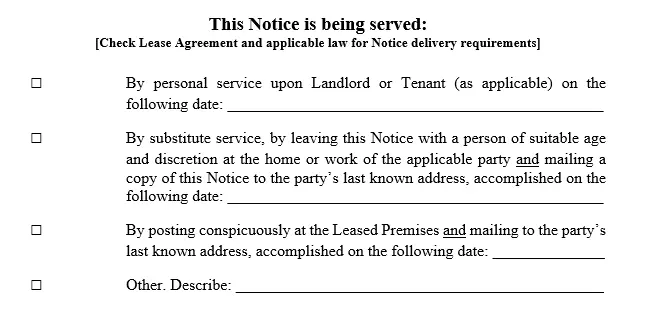
The sender has the responsibility to ensure that the notice reaches its receiver. In order to do so, the following methods are suggested:
- Box 1: Choose this if you plan to personally hand it in person. Make sure that you have a receiving copy of the notice where the receiver may sign and acknowledge receipt. Indicate the date when this meetup will happen on the blank.
- Box 2: If both the landlord and the tenant cannot meet personally, they may hire a courier (through a certified mail service) or ask a trusted person to deliver the document.
- Box 3: Visibly posting the notice to move out is another option. This is often done at the leased property. However, you may need to be careful with how this impacts the receiver psychologically as it may become a source of shame or even violate their rights to privacy.
- Box 4: For most people, they choose to e-mail the notice. If this is something you’re comfortable with, choose the last box.
Step 8— Sign the notice.

Just like how you signed the original lease agreement, you must also write your printed name on the blank and sign the letter, finalizing the termination of tenancy.
Whether you’re the landlord or the tenant, terminating a lease agreement should be done properly. Just like how both parties were attentive to the lease agreement when they first began the tenancy, landlords and tenants must keep their relationship civil and respectful. The best way to end it, of course, is through another written agreement.
